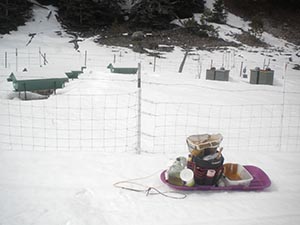
It is December, and you have completed your first, or another, year of beekeeping. Congratulations! A statistic frequently cited is that about 80% of the people who start beekeeping will quit. I can completely understand why this might be so. To the unsuspecting, it would seem like you could buy a colony and the equipment to put it in, place it in the corner of the backyard, and the rest would be easy. In the pre-bee imagination, it seems like getting honey bees will be like getting a puppy; spend a little time in training, and let him run in the backyard. In reality, the care of honey bees has more in common with livestock care than it does with pet care, and most people have never owned nor cared for livestock. Beekeeping has its share of heartbreak, too, which the uninitiated would never imagine.
The heartbreak comes from the way we fall in love with our bees, the peacefulness of beekeeping, how it makes your world seem like everything is all right; and then the loss of our bees and all that they gave us. Losses are a surprise to beginners, and the difficulty in understanding the cause, to learn from it, is discouraging. So, right now, at the close of the beekeeping year, let’s figure out how to make beekeeping sustainable. What we want to do is figure out how to make beekeeping not only something you would never want to quit, but also something that you can keep up with minimal inputs from outside. The bee hive should not be just a box to pour money into.
Step one to making beekeeping something you would never want to quit is figuring out how to have bees that survive. In these articles over this year, I have sprinkled some “rules” of beekeeping. If there were real rules, beekeeping would be so much easier. You could go out on June 5th and give the bees “x,” and then on July 15th give them “y,” and on September 2nd take away “z,” and everything would be fine. Beekeeping is more about assessing the situation, and figuring out what they need, and when. These “rules” I’ve talked about are really mottos of good beekeeping that can guide you in good decision-making.
- Good beekeeping is doing what needs to be done, when it needs to be done.
- Our goal as beekeepers is to help the bees do what they are trying to do, not make them do what we want them to do.
- Learn bee math, it is important.
- Monitor for mites, treat when necessary, re-queen colonies that allow mite numbers to climb, practice Integrated Pest Management.
- Be patient. If you don’t know what to do, do nothing.
- Find a mentor, call him or her frequently, even if you don’t have a problem. Talk beekeeping with every beekeeper you meet. Take advice from those with good survival rates.
- Read!
Step two to keeping bees alive is to learn to be a proactive beekeeper, but not an over-reactionary beekeeper. This is a delicate balance to find, since we are making decisions on what the bees need based on what we see when we inspect our colonies. What I mean is, rather than waiting until the bees are starving to death to feed, be aware that they have a need, and fill it. Imagine this scenario as an example: It is July, and you notice that there is a lot less brood all of a sudden. You aren’t sure why this might be. There might be a dearth beginning, in which case less brood is a good thing, the colony is conserving resources until another flow begins. It might just be too hot, and the pattern is looser so that the brood doesn’t overheat. There could be a disease getting a foothold. A proactive beekeeper will ….


